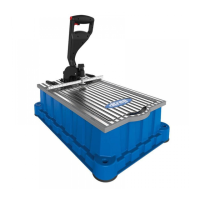Safety
!
!
!
WARNING This product contains one or more chemicals known
to the State of California to cause cancer and birth defects or other
reproductive harm. Wash hands after handling.
General Safety Rules
WARNING For your own safety, read the owner’s manual before
operating this pocket-hole machine.
WARNING Read all instructions. Failure to follow all instructions
listed below may result in electric shock, re and/or serious injury.
The term "power tool" in all of the warnings listed below refers to
your mains-operated (corded) power tool or battery-operated
(cordless) power tool.
SAVE THESE INSTRUCTIONS
1) Work area safety
a) Keep work area clean and well lit. Cluttered or dark areas invite
accidents.
b) Don’t use power tools in a dangerous environment. Don’t use
power tools in damp or wet locations, or expose them to rain.
c) Do not operate power tools in explosive atmospheres, such as
inthepresenceofammableliquids,gasesordust. Power tools
create sparks which may ignite the fumes or dust.
d) Keepchildrenandbystandersawaywhileoperatingapower
tool. Distractions can cause you to lose control.
e) Make your workshop child proof with padlocks, master switches,
or by removing starter keys.
2) Electrical safety
a) Do not expose power tools to rain or wet conditions. Water
entering a power tool will increase the risk of electric shock.
b) Donotabusethecord.Neverusethecordforcarrying,
pulling or unplugging the power tool. Keep cord away from heat,
oil, sharp edges or moving parts. Damaged or entangled cords
increase the risk of electric shock.
c) Use a proper extension cord and make sure it is in good
condition. When using an extension cord, be sure to use one heavy
enough to carry the current your machine draws. An undersized cord
causes a drop in line voltage resulting in loss of power and
overheating. Table1 on the following page shows the correct cord
gauge to use depending on cord length and nameplate ampere
rating. If in doubt, use the next heavier gage. The smaller the gage
number, the heavier the cord.
3) Personal safety
a) Stay alert, watch what you are doing and use common sense
when operating a power tool. Do not use a power tool while
youaretiredorundertheinuenceofdrugs,alcoholormedication.
A moment of inattention while operating power tools may result in
serious personal injury.
b) Always wear safety glasses. Everyday eyeglasses only have
impact resistant lenses, they are NOT safety glasses.
c) Usesafetyequipment. Use a face or dust mask when the cutting
operation is dusty. Safety equipment such as a dust mask, non-
skid safety shoes, hard hat, or hearing protection used for appropriate
conditions reduces personal injuries.
d) Avoid accidental starting. Make sure the switch is in the off-
positionbeforepluggingin. Carrying power tools with your nger
on the switch or plugging in power tools that have the switch on
invites accidents.
e) Removeanyadjustingkeyorwrenchbeforeturningthepower
tool on. A wrench or a key left attached to a rotating part of the power
tool may result in personal injury.
f) Donotoverreach.Keepproperfootingandbalanceatall
times. This enables better control of the power tool in unexpected
situations.
g) Secure workpieces. Use clamps or a vise to hold work when
practical. This is safer than using your hand and it frees both hands to
operate the tool.
h) Never stand on the machine. Serious injury could occur if the tool
tips or if the cutting tool is unintentionally contacted.
i) Dress properly. Do not wear loose clothing or jewelry. Keep
your hair, clothing and gloves away from moving parts. Loose
clothes, jewelry or long hair can be caught in moving parts.
j) If devices are provided for the connection of dust extraction
and collection facilities, ensure these are connected and
properly used. Use of these devices can reduce dust-related hazards.
4) Power tool use and care
a) Keep guards in place and in working order.
b) Do not force the power tool. Use the correct power tool for
your application. The correct power tool will do the job better and
safer at the rate for which it was designed.
c) Use right tool. Don’t force tool or attachment to do a job for which
it was not designed.
d) Do not use the power tool if the switch does not turn it on
and off. Any power tool that cannot be controlled with the switch is
dangerous and must be repaired.
e) Disconnecttheplugfromthepowersourceand/orthebattery
packfromthepowertoolbeforemakinganyadjustments,
changing accessories, or storing power tools. Such preventive
safety measures reduce the risk of starting the power tool accidentally.
f) Never leave tool running unattended. Turn power off. Don’t
leave tool until it comes to a complete stop.
g) Store idle power tools out of the reach of children and do
not allow persons unfamiliar with the power tool or these
instructions to operate the power tool. Power tools are dangerous
in the hands of untrained users.
h) Maintainpowertools.Checkformisalignmentorbindingof
movingparts,breakageofpartsandanyotherconditionthat
may affect power tool operation. If damaged, have the power
toolrepairedbeforeuse. Many accidents are caused by poorly
maintained power tools.
i) Keep cutting tools sharp and clean. Properly maintained cutting
tools with sharp cutting edges are less likely to bind and are easier to
control.
j) Use the recommended speed for the cutting tool or accessory
and workpiece material.
k) Onlyusepartsandaccessoriesrecommendedbythe
manufacturer. Consult the owner’s manual for recommended
accessories. Using improper accessories may cause personal injury.
l) Usethepowertool,accessoriesandtoolbitsetc.,in
accordance with these instructions and in the manner intended
for the particular type of power tool, taking into account the
workingconditionsandtheworktobeperformed. Use of the
power tool for operations different from those intended could result in
a hazardous situation.
5) Service
a) Haveyourpowertoolservicedbyaqualiedrepairperson
using only identical replacement parts. This ensures that the
safety of the power tool is maintained.

